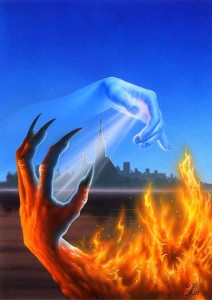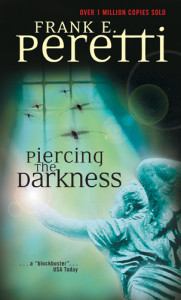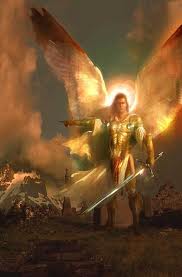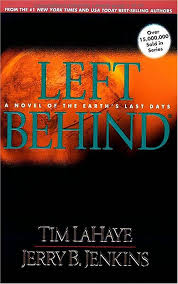 There is a whole world of Christian fiction out there, to the tune of at least one and a half billion dollars a year in sales. Romance, speculative fic, mysteries, thrillers, kids and YA, historical, mainstream—etc. There is even a Christian version of amazon.com for all your evangelical reading needs, currently listing 37,808 fiction titles. So, I thought I’d look at a couple that could be classified as speculative fiction, chosen on the basis of…well, having borrowed them from a cousin some years back, and forgetting I had them. But they were best-sellers in their time, are still selling well, and are presumably representative of the A-list end of the genre.
There is a whole world of Christian fiction out there, to the tune of at least one and a half billion dollars a year in sales. Romance, speculative fic, mysteries, thrillers, kids and YA, historical, mainstream—etc. There is even a Christian version of amazon.com for all your evangelical reading needs, currently listing 37,808 fiction titles. So, I thought I’d look at a couple that could be classified as speculative fiction, chosen on the basis of…well, having borrowed them from a cousin some years back, and forgetting I had them. But they were best-sellers in their time, are still selling well, and are presumably representative of the A-list end of the genre.
Frank Peretti is the Stephen King of the Christian speculative fiction world. His books have sold by the millions, and (according to reviews on the ‘net) are read not just by the religious but by people who enjoy the supernatural content, in the same way they enjoy the supernatural in Mr. King’s books. His Piercing the Darkness is still in print and selling well, which is pretty good for a genre novel originally published in 1989. Amazon notes that it has sold over two million copies.
The plot involves a vicious conspiracy of demon-inspired humans to defeat the local Christians and convert everybody else to various New Age and/or secular humanist creeds: because everybody knows that New Agers, secular humanists, atheists, feminists, liberal theologians, civil rights activists and post-modernists are all closet Satanists in league with the devil and his minions. Peretti shows us these demons swarming invisibly in the air, prodding or whispering to or even bodily harming their human objects.
various New Age and/or secular humanist creeds: because everybody knows that New Agers, secular humanists, atheists, feminists, liberal theologians, civil rights activists and post-modernists are all closet Satanists in league with the devil and his minions. Peretti shows us these demons swarming invisibly in the air, prodding or whispering to or even bodily harming their human objects.
But fear not! For ranged against these demonic forces, we have an A-Team of seven-foot-tall angelic warriors with big shiny swords! And every time the Christians go up against the New Agers and secular humanists, etc, the air is thick with demons and angels scrapping away beside them; though the angels can only be strong and effective when the Christians pray hard enough—that is essentially how their batteries are charged. Sans prayers, those big shiny swords are about as effective as weapons-grade toothpicks.
 These angelic X-Men are led by Tal, the Captain of the Host, a Nordic blonde who is very macho for a presumably nadless angel, a sort of Conan the Ineffable. The rest are a politically correct rainbow: Guilo, the “Strength of Many”, an excitable Latin type; Nathan the Arabian; Armoth the African; Signa the Oriental; Chimon the European; Mota the Polynesian; Scion, the “redhaired freckled fighter from the British Isles”; and Cree, the Native American. (And here I thought the angels were created at the beginning of time, well before human ethnic divisions had time to take hold.)
These angelic X-Men are led by Tal, the Captain of the Host, a Nordic blonde who is very macho for a presumably nadless angel, a sort of Conan the Ineffable. The rest are a politically correct rainbow: Guilo, the “Strength of Many”, an excitable Latin type; Nathan the Arabian; Armoth the African; Signa the Oriental; Chimon the European; Mota the Polynesian; Scion, the “redhaired freckled fighter from the British Isles”; and Cree, the Native American. (And here I thought the angels were created at the beginning of time, well before human ethnic divisions had time to take hold.)
Peretti can really write. He actually had me cheering for the angels against those nasty old atheists now and then. But one aspect in particular was disturbing: what is fantasy to a nonbeliever is truth to many of Peretti’s readers. In their minds, demons and angels do swarm around us, and prayer is a powerful force. What even some Christian reviewers are uneasy about is the reinforcement of the paranoid Fundamentalist conviction that there is indeed a demonic conspiracy against the faithful, one of the signs of the end times.
Which brings me to my second example: Left Behind: A Novel of the Earth’s Last Days by Tim Lahaye and Jerry B. Jenkins, first  published in 1995. It is, of course, the first volume of what became a publishing phenomenon, virtually an industry: sixteen volumes published between 1995 and 2007, all of them best sellers and selling cumulatively over 60 million copies; plus three movies, audiobooks, graphic novels, a YA spinoff series, and even a computer game. I read exactly one of the books. For me, one was more than enough.
published in 1995. It is, of course, the first volume of what became a publishing phenomenon, virtually an industry: sixteen volumes published between 1995 and 2007, all of them best sellers and selling cumulatively over 60 million copies; plus three movies, audiobooks, graphic novels, a YA spinoff series, and even a computer game. I read exactly one of the books. For me, one was more than enough.
The series recounts the adventures of the so-called “Tribulation Force,” a disaster-movie-type miscellany of people who were “left behind” in the Rapture. The eschatology followed in Volume One is basically the one I grew up with (Rapture, Antichrist, Seven Years Tribulation) though I am not sure which scenario they followed through with, because they took fifteen more volumes to reach Armageddon than I had any intention of reading, though I glanced through a few in the library to check that the style was consistent.
Unlike Peretti, these guys could not write their way out of a paper bag. Make that a torn paper bag. The books are turgid, stereotyped, and preachy: dreadful dialogue, paper characters, pages and pages of prayers and sermons. They are essentially large-scale religious tracts. And why would they sell so well? Possibly because their main readership sees all this not as fantasy but as a fictionalized preview of the imminent future; and maybe they actually enjoy prayers and sermons.
Left Behind begins with the Rapture: all over the world, millions of people suddenly vanish into thin air, leaving behind their clothes, eyeglasses, and jewellery—and, I suppose, if you work through that logic, their glass eyes, prosthetic limbs, breast implants, false eyelashes, dental bridges, and so forth. These are the born-again Christians, plus all the innocent of the world, meaning all the babies and children up to about age ten, which seems tough luck for the eleven-year-olds, and raises some serious questions about free will.
In fact, I’m not sure the authors thought things through very well at all. Picture many millions of Christians arriving in heaven all at once—naked. The horde includes millions of squalling babies and confused kiddies; plus, since conservative Christians oppose abortion on the grounds the embryo is a human being from the moment of conception, the new arrivals must also include a whole whack of embryos, right down to formless clusters of cells. Indeed, there is a scene of a woman in labour, whose abdomen suddenly flattens right out because the baby has been raptured away; obviously Messrs Lehaye and Jenkins never experienced getting their figures back after childbirth. Logical absurdities like this would not get by in good sf, but they can survive in a Christian bestseller because—in my humble opinion—many Christians have a lot of practice at jumping over logical gaps without noticing they’re there.
Okay, I did look at a few other works of Christian sf, plus a lot of Christian fanfic, and I did form some general impressions. First, the Christian SF genre covers a wide range of quality, from rather good to bloody awful, exactly like secular fiction. But does it work as SF? My answer is no, not really. Why not? The answer is NOT all those pages of sermonizing; Robert Heinlein, for example, filled his books with sermons of a sort, and his books do work as SF. And it wasn’t the interruptions for soul-searching and prayers, however boring; after all, romantic novels get interrupted for kissy stuff, which I find equally boring, but it apparently works for that genre. No, I see a different fatal flaw.
Christian fiction, almost by definition, involves somebody making a spiritual journey towards redemption through Christ’s blood; or an existing Christian seeking to keep in line with God’s will. Otherwise the characters pretty much have to be either born-agains or bad people. In fact, defining the characters’ relationship with God is what passes for character development in the works I looked at.
There are two consequences: despite the writer’s best efforts, the characters are almost inevitably going to be stereotyped. And, whereas secular SF offers an almost unlimited number of vectors a character can follow, a Christian-SF protagonist can only go to or from Christ. Those are very serious limitations.
[Sheepish note to cousin: you can have your books back now.]

